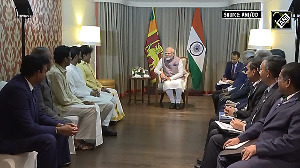Banks are getting more reluctant to extend study loans thanks to the extent of default in this segment. A look at the new roadblocks on the education highway.
Studied Default
College fees -- two words that can strike terror in the heart of any parent. And if their offspring decides to take a professional course, or decides to get a master's degree, woe betide the fond parents. The minimum fee at an engineering college is Rs 35,000 (the better ones charge more), while an MBA can cost around Rs 2 lakh (Rs 200,000); at a foreign university the same comes with a tag of Rs 15 lakh (Rs 1.5 million) or so.
Yes, this is bad news, but here's worse. Banks are no longer offering study loans with the open-handed generosity of a few years ago, especially to students who plan to study abroad. The reason for this is that the default rate is rising in banks' education loan portfolios. According to a public sector bank official, the problem of default is worse in the case of overseas education, as students change their address without informing the bank.
Even students from prestigious engineering and management institutions default on their payments. And banks find it difficult to track them given the trend of job-hopping and city-hopping. Kiran Rao, for instance, took a study loan of Rs 12 lakh (Rs 1.2 million) from a public sector bank in 2004 to complete her engineering degree from a college in Bangalore. She then landed a job with an MNC in the US, where she's possibly raking in dollars now. But the bank hasn't heard from her in over two years, and Rao has not been bothered to pay back her education loan.
But given their social responsibilities and policy pressures, banks cannot simply stop giving study loans. Instead, they have decided to tighten the lending process, so that their NPAs in this segment do not become unmanageable.
What's new
The Indian Banks' Association (IBA) has set up a working group to figure out how study loans can be made a viable business. Based on its recommendations, banks have revised their norms.
Most banks have now made it mandatory for the student's parents or guardians to be co-borrowers and therefore liable for repayment. Rajan Ghogalkar, corporate head, retail banking, IDBI Bank, says, "Our study loan revolves around the borrower's parents. It is sanctioned only after checking the parents' residence. They are also made co-borrowers to ease the recovery process." This also makes it easier for banks to trace the student's whereabouts.
The working group has also suggested that banks should disburse loans from branches close to the permanent residence of the student-borrower. This would help banks to recover loans in a cost-efficient manner.
Cover the risk
The IBA group has also mooted a Rs 250-crore (Rs 2.5 billion) Credit Guarantee Fund on the lines of the Credit Guarantee Trust Scheme for small-scale industries. This would cushion loan defaults, and will also serve as a group insurance product.
It has been suggested that half of the corpus be funded by the central government, while the rest could be shared by the banks and the borrower. The student-borrower will be charged a premium of say Rs 10-15 per Rs 1 lakh (Rs 100,000) borrowed, and the bank can claim the insurance, if the student defaults. The proposal is under consideration of the Reserve Bank of India and the Union Ministry of Finance.
Some banks already insist on an insurance policy to cover such a loan. UTI Bank, for instance, asks borrowers to take an LIC policy that covers 10 per cent of the loan, while Andhra Bank offers an insurance cover to protect the students and their parents.
Most overseas universities insist on mandatory medical insurance and have a waiver clause if the student has a comparable insurance policy in the parent country. On the whole, it's a good idea to take insurance here, as foreign policies generally cover only medical expenses. They are also far more expensive -- the difference in costs can work out to around Rs 35,000. It takes about a day to get the right insurance; the insurance company will demand to see the student visa and the admission letter before it sells you the appropriate cover.
Loans on offer
Like we said, banks are still giving study loans, despite the higher default rate. All the loan products in this portfolio follow the RBI-approved model education loan scheme. The quantum and term of loans may vary from bank to bank, and also
Before giving the loan, banks study the viability of the borrower based on personal discussions with the student, family's assets and annual income, the nature of the course and reputation of the institute.
The best deal
The problem with study loans is that few banks offer a concessional rate. In general, banks charge 10.75 per cent on loans below Rs 4 lakh (Rs 400,000) and 11.75 per cent on loans above Rs 4 lakh. (For loans up to Rs 4 lakh, banks lend at their prime lending rate, and 1 per cent above PLR for loans exceeding Rs 4 lakh).
Some banks do offer lower rates to women students or those from specified institutions. Andhra Bank, for instance, extends loans at 10 per cent to students of select institutes, while women enjoy a discount of 0.5 per cent.
Students, who show signs of good financial discipline, get a further discount of 0.5 per cent. Bank of Baroda also offers a 1 per cent discount to women students under its three schemes -- Baroda Vidya, Baroda Scholar and Baroda Gyan.
The best banks to approach for these loans are public sector banks, as most private and foreign banks virtually ignore this segment. HDFC Bank does not offer study loans, while for ICICI Bank it is not a priority area, though it does have one study loan on offer. HSBC is the only foreign bank that lays emphasis on its study loans; the bank also offers scholarships for students wanting to study in the UK.
So, why do private banks eschew this segment? A senior official at a private bank says that this is a highly regulated segment with set guidelines that prohibit rejection of applications, which goes against the lending habits of private and foreign banks. The other problem is that institutes and universities are very often outside the private banks' geographical territory. Public sector banks are better placed to serve these places.
Tax benefits
While banks are not too sure about the viability of these loans, borrowers are not complaining. After all, repayment of a study loan is deductible under Section 80E of the Income Tax Act. The annual limit for deduction is Rs 40,000 (principal and interest), but will apply only on loans taken for higher education -- graduate or post-graduate, professional, and pure and applied science. The deduction will be available for a maximum of eight years starting from the day of repayment.
Ready Reckoner
Want a loan for that course abroad or an MBA? Check out these basics before you go to a bank for funds.
Interest rate Banks charge 10.75 per cent on loans below Rs 4 lakh and 11.75 per cent on loans above Rs 4 lakh. Some banks offer 0.5 per cent discount to women.
Limits. The maximum loan amount is capped at Rs 7.5 lakh (Rs 750,000) for studies in India and Rs 15 lakh for studies abroad. The minimum loan amount is Rs 50,000.
Charges. There is no additional charge or processing fee and banks do not ask for any margin for loans up to Rs 4 lakh. For loans exceeding Rs 4 lakh, borrowers should pay 5 per cent of margin money for domestic loans and 15 per cent margin money for overseas loans.
Processing time Depending on the bank, loan amount, and the paperwork required it takes anything from two days to a week for the loan application to be processed.
Repayment. The repayment would begin one year after the course period or six months after the student secures a job, whichever is earlier. The period for repaying the loan is generally five to seven years and could be linked to the increment in the borrower's salary.
Collateral. Loans up to Rs 4 lakh do not require collateral. For loans over Rs 7.5 lakh, banks seek collateral in the form of property, government securities, public sector bonds, units of UTI, NSC, KVP, LIC policy, gold, shares/ debentures, bank deposit in the name of the student/parent/ guardian or any other third party with suitable margin.
Documentation. The bank will demand your admission card, schedule of expenses, copies of letters confirming scholarship, etc, copies of foreign exchange permit, if applicable, statement of bank account for the past six months of the borrower and income-tax assessment order not more than two years old, along with a brief statement of assets and liabilities of the borrower.






 © 2025
© 2025